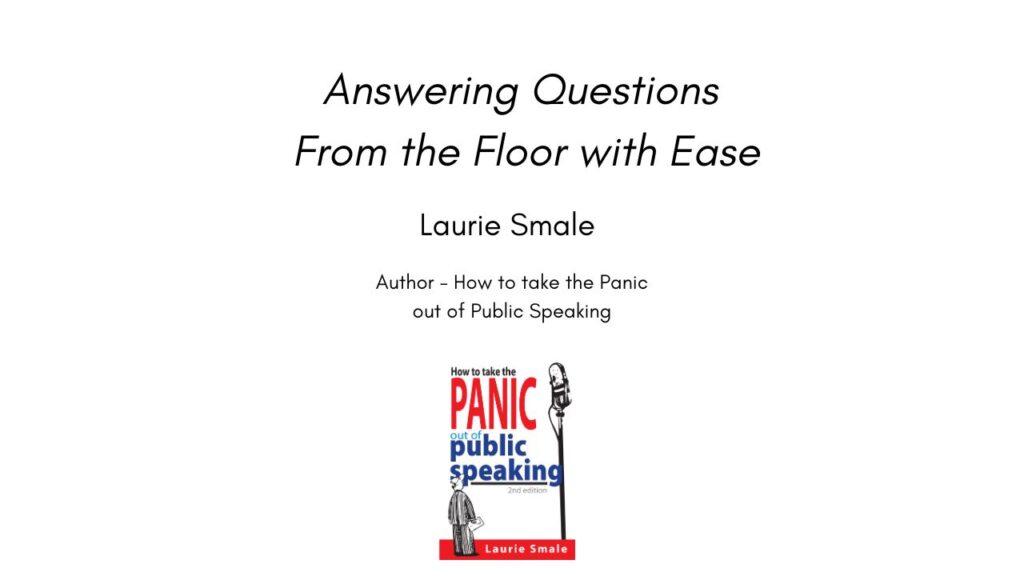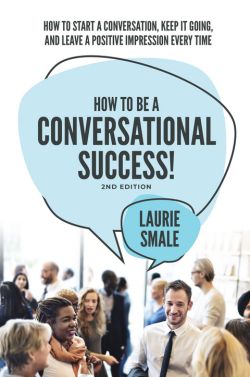Article Answering Questions From The Floor With Ease
How often do we see speakers sail through their talks only to founder on the rocks of Question Time. Here’s how to steer clear of them.
Answering Questions from the floor with Ease with Master Speech Coach and Inspirational Speaker Laurie Smale.
1. Make things easy for them: During question time, many people are self conscious of being evaluated or saying something that might highlight their ignorance on the subject. So many stimulating ideas remain unsaid. Glen Capelli, Australia’s representative on the International Board of Accelerative Learning says he never launches into question time with the somewhat brusque, “Are there any questions?” He prefers a more gentle approach where he invites people to ask each other what it all means to them. When everyone is ‘primed’ with concrete things to say, he asks: “Has anyone got any further observations? Comments? Questions?”
2. Ask the first question yourself: Another friendly approach to break down communicating inhibitions in the audience could be that you ask the first question yourself. “When sharing these ideas a question I’m often asked is, ‘….’”? Preface your answer with, “And what I say is…” Then, in a non-threatening manner ask your audience, “Who has the next question?” as if it were they who proffered the first one! Then again you could seed the audience with a couple of your friends as questioners to start the ball rolling. Once somebody breaks the ice, others have the confidence to share their thoughts and feelings on the subject too.
3. Include everyone in your response: Remember not to direct your entire answer at the person who asks the question. Thank them for their question, and then relate your response to the rest of your listeners as well. This way you’ll include everybody in the mental interaction whether they ask a question or not. And the best way to do this is by answering with simple stories or analogies your listeners can identify with. Your examples should last no longer than about thirty seconds.
4. Answer with a story: Once during question time the erudite Australian Historian, Professor Blainey, was asked if he had any idea of what it must have felt like to be an early settler in Australia. He let his mind tick over for a few seconds then related the story of how he and his mate went to work on a farm at Horsham in Victoria’s wheat-growing Mallee region during the holidays when they were about fifteen. I’ll never forget the image of those two young boys sweating it out in the blazing sun, pitching hay high up on to a horse-drawn cart while the farmer straddled the top of the heap lording it over them. This simple incident more than answered the question of what early settler life might have been like.
5. Be honest: If you don’t know the answer to a particular question, simply say so. People are reasonable. They understand that you can’t know everything there is to know. And they understand that information moves pretty fast nowadays! Usually a friendly “See me over coffee and I’ll point you in the right direction” will suffice. But if you don’t know the answer to a question you should know, be honest and own up to the fact. Not long back I was at a parent information night at our local school. During question time the sports coordinator was asked about the printed programs that were supposed to be there for the Twilight Carnival in two days time. She said, “To be honest they’re sitting at home on my desk. I was up till 1am this morning marking exam papers and I simply rushed out this morning and forgot them…and I apologise for this. They’ll be available at the front desk from 8:30am onwards in the morning.” I remember thinking to myself, “That’s fair enough, it’s not the first time I’ve been guilty of the same sort of thing”… and not giving it another thought. I sensed that most other parents felt like this too. By being honest and admitting up front what had happened we warmed to the fact that she was subject to the same human frailties as the rest of us!
6. Stay in control: On rare occasions a person will persist with something controversial or outside the scope of your talk. Under no circumstances get sucked into a one-on-one exchange. I learnt long ago that it’s never wise to argue with a fool because bystanders don’t know which is which. If your friendly offer of talking to them later doesn’t work, simply cease to look at them and move on to your next point. Most times, however, you’ll be on firm ground and be able to draw on your experience for an adequate answer.
7. Avoid sarcasm: An effective communicator never ever uses sarcasm. You’ll run the risk of getting everyone off side. Instead try and make the person giving you a hard time feel that their contribution is important: “Thank you for the question… that’s a valid point. We cover that later on.” It’s important you keep your promise and do so otherwise you’ll lose credibility. People are entitled to their opinion. Notice how I didn’t agree or disagree with the questioner’s point, I just said it was ‘valid’.
8. Use your audience as a Resource: Never be intimidated by those in the audience who know more about your subject than you do. Draw on them as a resource by respectfully inviting them if they have anything to add. Your listeners will appreciate your ability to draw on ideas and interact with people as a natural part of your presentation. Once during a business presentation a young woman asked me, “How do I cope with being asked to facilitate a meeting between six very senior engineers on a subject I have very little knowledge of?”
As I stood there formulating an answer, a man raised his hand and said, “I can answer that.” I gratefully nodded in his direction. He went on to say that recently he had found himself in a similar situation with some very senior scientific people. He soon discovered that his job was not to pit himself against their overwhelming knowledge. His task was to make people feel welcome, stimulate discussion, and steer the meeting to its expected outcome as per the agenda.
But most important, he discovered that someone had chosen him for the job because they believed he had the ability to do it! I watched this young woman listen in rapt attention as this man spoke. When he had finished I said, “Does that answer your question?” “Oh yes thank you”, she replied. So when someone offers a contribution in response to a question from the audience, welcome it. You’ll all be the richer for it.
9. Throw the Question Back to the Audience: At other times you could be pro-active in answering a tricky question by throwing it back to the audience. At a recent presentation on ‘How to Pool Your Talents and Work as a Team’ for the Junior Chamber of Commerce, I was momentarily stumped for an answer when a member of the audience asked: “Do you return to a hierarchical structure if a program on self-empowerment is not working?” I immediately transferred the pressure of this complex question to my listeners by inviting them to reflect on what they thought about it. The spontaneous open forum that followed enabled me to contribute something intelligent on the subject by bouncing off their ideas. The good thing was the audience felt that they had also played an integral part in contributing to the response.
10, Repeat the Question: Always repeat the question for the benefit of those who may not have heard it clearly. It’s quite annoying for a speaker to listen to a question from someone in the front row, and then proceed to answer in great detail a question that most of the audience didn’t hear! If the question is complex or convoluted, re-word it so that you understand it clearly. Confirm that you have the question right. And after your response, go back to the person and check that they are satisfied with the answer.
11. Have the last word! Here’s how to ensure your listeners walk away with your main message and not the answer to your last question. Take control of the end of the session with an observation such as, “Time’s caught up with us… we have time for one more question…” When you have answered this question restate the main message of your talk once again. That is, prepare two conclusions that say the same thing – one for the end of your talk and one for the end of question time. This will avoid a wishy-washy ending such as “That’s about all I’ve got to say” and lead them back to the main essence of your talk.
12. In a Nutshell and Invite Questions
- Many people are self-conscious of being evaluated or their ignorance on the subject. Invite people to ask each other what it all means to them. Then ask: “Has anyone got any further observations? Comments? Questions?”
- Break down communicating inhibitions by asking the first question yourself
- ‘Seed’ the audience with two questioners to get the ball rolling
- Don’t direct your entire answer at the person who asked the question, include the rest of your listeners as well
- Always thank the person for their question, then check with them to see that you’ve answered it adequately
- We can’t know everything. If you don’t know the answer to a question simply say so
- Be firm with a persistent questioner. If your friendly offer to talk to them later doesn’t work, break eye contact and move on to your next point
- Never be intimidated by those in the audience who know more about your subject than you do. Use them as a resource
- Always repeat the question for the benefit of those who may not have heard it clearly
- If a question is particularly sticky, buy a little time to formulate an answer by having a sip from your glass of water
- At the end of question time, restate the main message of your talk once again.
Extra Tip: On occasion you could invite questions during your presentation rather than an allotted question time at the end. This injects a dynamic two-way feel to your talk, helps you stay in control and finish with impact.
These tried-and-proven public speaking tips reflect the exciting outcomes embodied in my second edition best-selling classic book, ‘How to take the Panic out of Public Speaking.’

© Laurie Smale Inspirational Speaker, Speaking Coach, and Author
ARTICLE // Answering Questions From The Floor With Ease
By Laurie Smale, Author, How to take the panic out of public speaking 🎤
- Make things easy for them
- Ask the first question yourself
- Include everyone in your response
- Answer with a story
- Be honest
- Stay in control
- Avoid sarcasm
- Use your audience as a Resource
- Throw the Question Back to the Audience
- Repeat the Question
- Have the last word!
- In a Nutshell and Invite Questions
Read all the details at https://lauriesmale.com/blog/article-answering-questions-from-the-floor-with-ease
All of my practical coaching wisdom is in my three books available at https://lauriesmale.com/books
#lauriesmale #article #howtotakethepanicoutofpublicspeakingbook #publicspeaking #answeringquestions
Shared Online Archive.org Facebook Page Facebook Profile Google LinkedIn Page LinkedIn Profile Twitter / X








